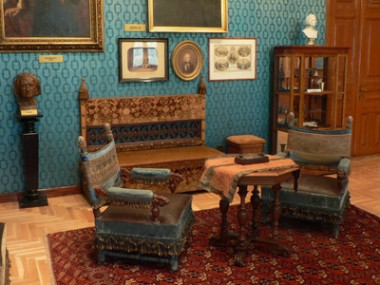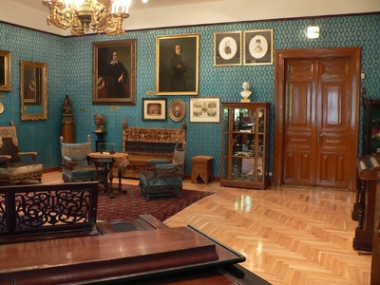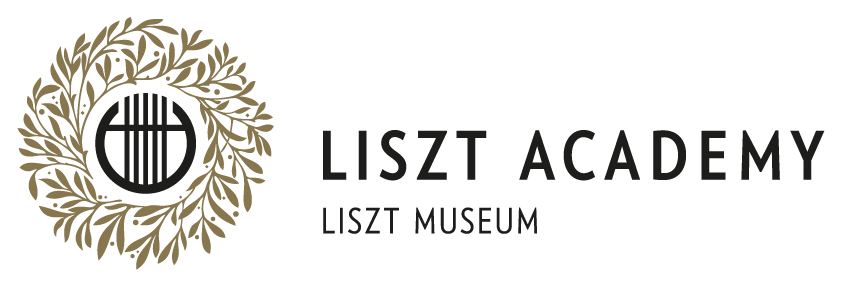Drawing room
4 arm chairs, one so-called X-seat, one Ottoman stove-bench and a card-table, these were the pieces of furniture which formed the combined furnishings with plush drapery and leather-cover designed by Fellner in the style of Henry II.

The 2 piano stools were made of cane interweaved with silk as Liszt preferred to play the piano sitting on a cane interweaved chair. The embroideries of all the pieces of furniture, pillows, curtains and table-clothes were done by a 15-member-company of ladies. The embroidery of the X-chair was designed by Fellner, but all other embroideries of the ladies followed old Hungarian patterns. These artistic embroideries were quite different from the decoration of the fashionable salons. After the death of Liszt, when the flat had to be made free for teaching purposes of the Academy of Music, the donators received back the pieces of furniture. After a couple of years it was possible to obtain them back for the Liszt memorial collection at the Academy of Music.
In one of the corners of the drawing room we can see the miniature Beethoven statue made of bronze, with which Liszt was presented by the Viennese Beethoven Committee. There are valuable paintings hanging on the walls, among them two drawings by Gustave Dore, which were illustrations after Liszt's Dante Symphony and the piano legend "St. Francois de Paule marchant sur les flots".
The other Chickering piano, which is in the drawing room, was specially made for Liszt, according to its Opus Nr. 50.080 around the turn of 1879/80. Inside the keyboard-lid, inscribed in gold letters: Chickering & Sons / à F. Liszt. Its range is AAA-c5 and its action is the same as in the other Chickering piano, but this instrument is much larger in size/260 cm long, 150 cm wide/, and cross-strung, having 3 pedals, of which the middle one is a divided damper level for increasing the volume of the treble notes. The case is laquered dark, with carved ornaments and carved legs, less decorated than the piano made for the world exhibition.
When in autumn 1880 Liszt -- staying in Italy -- learned Chickering's intention to present him with the piano, he wrote asking him to send the piano to the Academy of Music. Here it was finally placed it in the concert-hall near his flat, and both he and his students used this specially enduring instrument, the sound of which can still rival that of modern concert-pianos.
After Liszt's death the two Chickering pianos were regularly used at the Academy of Music, and in 1927/28 the manufacturing company hired them for a long American concert-tour. Nowadays they serve only for representative and museum purposes.

The music stand of silver was presented to Liszt in 1858. In the middle a Liszt relief, in the upper part three busts are seen: those of Beethoven, Schubert and Weber. The names engraved in the wide base are those of the donors, primarily from Liszt's circle in Vienna and Pest.
Liszt held his lessons most often in his drawing room, where - according to the descriptions of the time - there were always one or two Boesendorfer pianos. One of them has a serial number 7561 and the year of its manufacturing has not been precisely determined (around 1873). The short piano of 7 octaves range (AAA-a4), Viennese action, straight strung, with 2 pedals, is a special instrument. Inside its case under the strings a certificate reads in Hungarian and German: Mr. Janos Nepomuk Dunkl music-dealer, Henrik Gobbi professor of the Academy of Music, and Gusztav Chmel piano dealer, certify, that Liszt used this instrument at his flat in Pest between 1880-1886 until his death. The instrument has a mahogany plated case with sections varnished black and shows the ravages of time. Its complete and total renewal and restoration could only have been done at the cost of its authenticity. Its tuning is one complete tone lower and deeper than the original one, therefore on the CD-recordings demonstrating the sound of the instruments in the museum, the composition recorded on the Boesendorfer piano sounds a major second lower.
In the Budapest estate the large American harmonium has also remained, which was given to the Maestro in January 1877 by the Boston company Mason & Hamlin. The instrument with the mark "Style 496, No.90243" has a suction system, 5 octaves range (CC-c3). The instrument was made expressly for Liszt in 1876, afterwards the same type was manufactured in a series as well, named "Liszt Cabinet Organ", with a reference to Liszt's appreciation. Its 15 stops and knee-pedals (for varying the dynamics) produce a rather varied sound.
In his letter concerning the piano-harmonica Liszt also disposed of his other special instrument, the pianino-harmonium of Erard-Alexandre. This instrument had been transported to his flat in Pest and during his moves he had never parted from it. This combined instrument of two manuals is according to its inscriptions a "piano-orgue". The serial number of the pianino-part (37537-44236.8740 D.N.) refers to the fact that it was manufactured in 1866. The harmonium with a bellows system of 5 octaves (C-c4) with its narrow frontal part is lower. It is the work of Jacob Alexandre and son, one of the best-known harmonium-manufacturers of his time in Paris. The sound-box containing the strings of the pianino is wider and higher, the instrument has an iron-frame, and a range of 7 octaves (AAA-a4) supplied with a pianino una corda and a damp pedal (which can be found between the pedals of the harmonium). This part of the instrument was made by the Erard company, which had already supported Liszt as a child when he had arrived in Paris at the end of 1823, Liszt maintained a good relationship to their mutual advantage, which lasted until the death of the composer.
The vitrine nearby contains memorabilia of Liszt's artistic life. We can see here among other things his award certificate presenting the freedom of Sopron, and a silver conducting baton, with which he was presented by the town in 1846. On the lower shelf there are objects from his travels: his travelling case, lamp, writing utensils, writing box, his dummy keyboard, etc.



